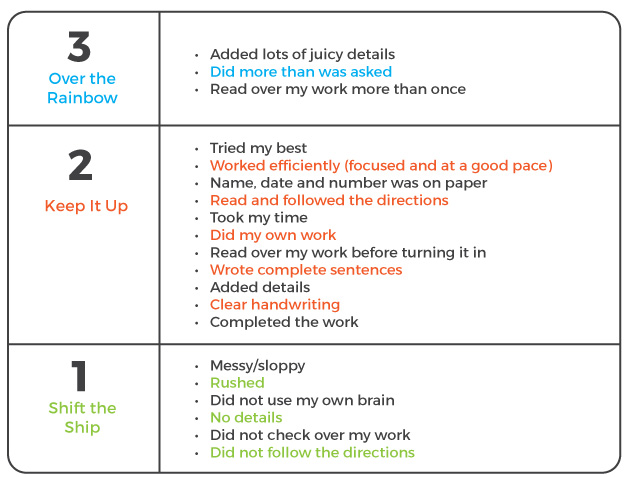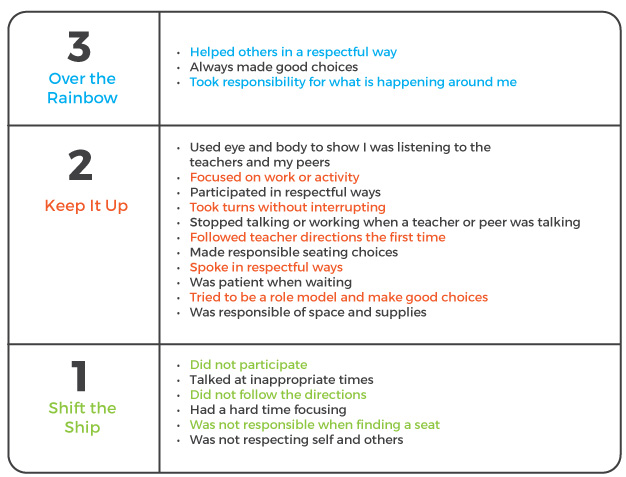Creating a Growth Mindset In and Out of the Classroom

We want our students to achieve growth, both in and out of the classroom. And we know that simple shifts and practice can have a profound impact on both their work and behavior. Building on Carol Dweck’s work on Growth Mindset and Carol Thomlinson’s Differentiated Instruction, we can design a roadmap for students to meet and even exceed expectations. First, we create the Best Work Rubric and next, we develop the Behavior Expectations Rubric to help create clear examples and explicit expectations. Through this process we foster a student’s understanding of intrinsic motivation and the empowerment that comes from growing and reaching goals.
Setting up the System – The Best Work Rubric
It is essential that your students create this rubric: the ownership has to be theirs. Begin the conversation with a discussion about what great work might look like and the process necessary to create great work. Students may say the process includes: working efficiently, thinking about the goals of their work, reviewing their work after they complete a task, reading directions carefully, or adding thoughtful details to their work. These student-generated descriptors become the base of the rubric, the expectations of their best work.
Since we always want to model growth and motivate students to reach higher, it is important to have a space in the rubric that describes what it looks like when they go above and beyond their best work. They will add descriptors such as: prioritizing their own work, doing more than what is asked, or reading over their work at least 2 times. Students don’t always strive to do their absolute best, so we want to offer language for when work does not quite show their potential. It is critical for young students to be able to reflect on their own work without making a judgment on their ability or self worth. By having a place on the rubric that clearly states what it looks like when they are not doing their own best work, it creates a window to these important conversations. We are teaching them that success is not pre-determined, but rather worked for through practice and with clear expectations.
Once the descriptors are placed on the rubric it is time to get creative and name each section with your students. The Best Work section can be named, Kaboom Work, Keep It Up, Bullseye, or Wow Work. Having the students come up with names and then vote on their favorite is key to making this system not only work, but fun. Work that is above and beyond could be called, Over the Rainbow, Out of this World, or Over the Top Work. Work that does not show a student’s best work could be called, Wah…Wah…Waaaah, Blah, or my favorite, Shift the Ship.
Best Work Rubric Example

Make it Meaningful
In order for this system to work it needs to be continually reiterated, consistently incorporating the terminology is key. The rubric should be posted on the wall, sent home, and adopted in all areas and subjects in the room. If you embrace it, the students will too. Asking kids to talk about their work and become more reflective takes time and repetition. They need to know that they will be required to use the rubric throughout disciplines and lessons, and throughout the year. It can truly be transformative for students to talk about their areas of growth and where they are excelling. They will become less worried about if an answer is correct or about getting a teacher’s approval, and became more thoughtful about the work they are turning in.
Connecting Best Work to Behavior Expectations
Once the Best Work Rubric is created and the students have become comfortable with the expectations and language, it is time to connect their great work to their behavior. Students often make good choices in the classroom but when they are in the halls, in special programs, and in the lunchroom they can become disrespectful, act out and have a hard time listening. The Behavior Expectations Rubric complements and connects directly to the Best Work Rubric. The same names should be used for each section, but new descriptors will need to be created by the students. Again, using the same terminology and reflecting regularly with the class will show the students that the rubric is meaningful and significant.
Behavior Expectations Rubric Example

Partnering Around the School
Once students fully understand the rubrics and are using them in the classroom it is time to partner with the specialists in Art, Music, Physical Education and Library to build a bridge between the classroom and their behavior in these special programs. First, it is a good idea to meet with each specialist, either in a group or one-on-one to get them excited about the Behavior Expectations Rubric and to help them understand how it works. The specialists must have buy-in to really make this work. The beginning lessons should be taught in the specials’ rooms, with both the classroom teacher and the specialist running the activity. Letting students physically see the connection between what happens in the classroom and what happens out of the classroom can be powerful. Have the students cross out the descriptors that don’t make sense in that given special. There are usually only one or two. Then have the students add descriptors that are uniquely important to that discipline. Although it can feel repetitive for you, it is essential that this same lesson be rolled out in each special. There are ways to make it feel more authentic for each discipline. For example, in the music room the students can pick instruments to represent each section. You then have the option to use the names the students have created or a musical sound.
Reflection, Reflection, Reflection
Once the stage is set, everyone, especially the teachers, needs to use the vocabulary to make the Behavior Expectations Rubric part of the culture. As students walk into their special, ask them to focus on one area of growth and what they will do to improve or shift their behavior. After that same special, ask your students to reflect on their goals and share where they fell on our Behavior Expectations Rubric. By having students hold up 1, 2 or 3 fingers on their chests you can get a quick read on where they fell on the rubric. It is also important to talk about the difference between having a moment where you were in Shift the Ship and were able to move into Keep It Up, as compared to a time when they remained in Shift the Ship and were unable to make that shift. These quick check-ins are key to keeping this vocabulary relevant and to help students see their own power in their choices. Throughout the year it is crucial to have regular check-ins with the specialist teachers and make adjustments when needed. More concrete reflection times and refresher lessons, where students talk with their peers about their strengths and areas of growth, will support students in growth. Some students may need a little extra help, so set clear individual goals and daily check-ins. When you take the time to show them it is important, they will act like it is important. We also have students complete a reflection and goal sheet twice a year. Focusing on making positive changes, we are more likely to see a shift.
Bringing in the Parents
It is also powerful to educate parents at Back to School Night on how to use this language. By coaching parents on how to use these rubrics when discussing work and behavior with their child, they will have vocabulary that can soften the sometimes stressful parent-child interaction. We encourage parents to ask their child to reflect on their work before or even in place of parents actually looking at it. The shift from just pointing out all the mistakes, to having conversations about the kind of work they are doing and what makes it their “best work” can be a relief to everyone. When an incident occurs at school and parents are notified, it helps the parents and their child focus and reflect on their own behavior instead of blaming. We have heard time and time again how parents begin using this language in other areas at home to make conversations easier and expectations more clear.
The True Test
The impact is clear when you begin to see the universal transformation in behavior. The change in the classroom is often instant. But when you see other teachers incorporate this process, or notice specialists create behavior rubrics with other classes, or when someone is excited to start from the top at the beginning of the year, or when a parent has stories about the change at home…you will know you have helped create a culture of communication around expectations and made a difference in areas where so many students often struggle. The Best Work Rubric and the Behavior Expectation Rubric give them a safe space to change and grow. Growth is inspiring, both to our students and those who encourage them.
Resources and Worksheets
____’s Behavior Expectation Goal
Reflection and Goal Setting Worksheet
Music Behavior Expectation Reflection
 Holly Dunn is a third grade teacher at Live Oak School in San Francisco. Holly has been teaching since 1997 in Maryland and San Francisco and has been a member of the Live Oak community since 2002. She also has participated in numerous workshops to support the work in her classroom, including several intensive Differentiated Instruction workshops, the annual National Council of Teachers of Mathematics Conference, and the White Privilege Conference.
Holly Dunn is a third grade teacher at Live Oak School in San Francisco. Holly has been teaching since 1997 in Maryland and San Francisco and has been a member of the Live Oak community since 2002. She also has participated in numerous workshops to support the work in her classroom, including several intensive Differentiated Instruction workshops, the annual National Council of Teachers of Mathematics Conference, and the White Privilege Conference.
